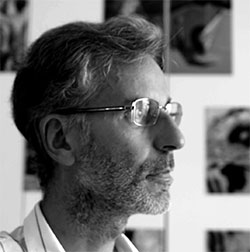I am more interested in "producing" an imaginary world than in "re-producing", reporting something real. Yet what I do is a kind of "street photography", and what I show in my photographs is closer to reality than one would think at first sight. I am not bound to a particular shooting or printing technique: I have explored most of them, from very old ones (pinhole photography, gum printing) to digital photography and printing, often mixing old and new in a single work.
Old techniques
The result of a photo is generally a bi-dimensional surface in which the original perspective and sense of space have been either deeply distorted or completely abolished. Yet, when printed, it is a three-dimensional object that one can handle and touch. As such, it possesses material, tactile qualities. The film itself has a structure, the grain, which contributes to the pattern of the final result. In other cases, the pattern is provided by the paper itself. I like to explore these aspects, also by experimenting with printing on various kinds of non-photographic papers, such as Japanese paper, handmade cotton paper or else, both in black and white and in colour. In the first case, after a possible sizing of the paper with a gelatine coat, I brush the light-sensitive silver gelatine, and then process it in the dark room. The colour process ranges from the ink-jet printing with archival pigments on brush-coated Japanese paper to the more demanding “gum-dichromate printing” on hand-made, cotton paper. In this case, I prepare by myself the various coatings of UV-sensitive photographic emulsion, pigmented with yellow, magenta and cyan watercolour, or other pigments as well. On the resulting print, the fine grain details of the original negative are lost, replaced by the brush patterns and the fibre of the paper.
3D
Along the same line of research on the possibility of producing a tactile experience are my experiments with the 3D lenticular printing technique. In this case the impression of depth is produced by elaborating on the computer a 2D photography, and in purpose it does not correspond to the depths of the original object. I produce in this way a puzzling yet exciting visual experience.
Videos
Viewing always involves a motion in time, because we cannot embrace an entire picture at a glance. Creating a sequence, a movie, is a way of “ordering” this motion in time, and allows me to play with sights and sounds. Thanks to our memory, the single scenes, the emotions they produce, make up one big “walk through an exhibition”. The two-dimensional photos become then one three-dimensional object. A further evolution is embedding in this memory-induced 3D impression a virtual 3D video experience.
360 degrees 3D Videos
Panoramic three dimensional videos are for me a further step in the elaboration of photographic material toward the realization of a full immersive esthetic experience. Differently from the case of usual videos, here the viewer is always seeing just a part of the scene, while there is something that occurs behind, and gets unobserved. Viewing such a video is therefore never a closed experience: no one sees everything of what happens, everyone has therefore a different, personal experience, depending on his way of going through the visual material.
Virtual reality
The natural step after 360 degrees videos is the realization of virtual reality apps, that allow to create a virtual world in which one does not only choose the direction in which to look at, but also his position in the virtual space. He can therefore "walk through" a visual and musical world.
Music
I like music in general and, when I have time, I play keyboard instruments. Click here to find a description of my clavichord and listen to some examples of the music I play on this instrument.

